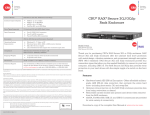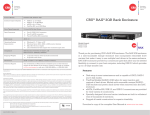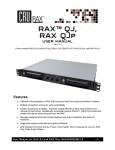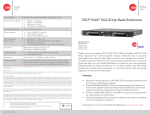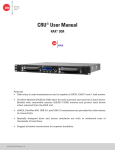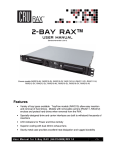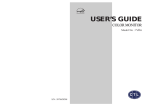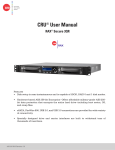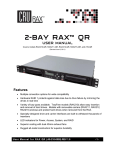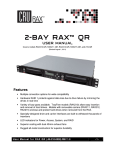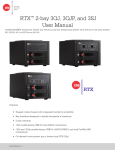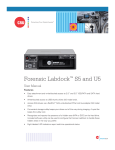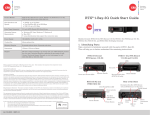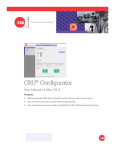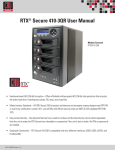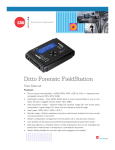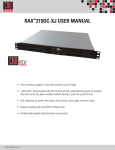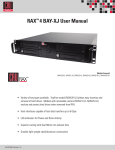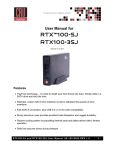Download CRU User Manual
Transcript
CRU User Manual RAX Branding RAX® 3QJ RAX® 3QJp 2c85m76y PMS 711C 68c70m PMS 2726 Features • Optional write protection on the RAX 3QJp unit prevents data from being overwritten or altered. • TrayFree Models (RAX210) allow for easy insertion and removal of hard drives. Models with removable carriers (RAX211) enclose and protect hard drives when removed from the RAX unit. • eSATA, FireWire 800, USB 2.0, and USB 3.0 connections are provided for wide variety of connectivity. • Specially designed drive and carrier interfaces are built to withstand tens of thousands of insertions. A9-210-0011 Revision 1.0 Table of Contents 1. Pre-Installation Steps 1.1 Box Contents 1.2 Identifying Parts of your RAX800-TR 1.3 Warnings and Notices Forensic Device User Advisory (3QJp Models Only) 2 2 2 3 2. Installation Steps 3 2.1 Installing Hard Drives 2.2 Selecting the Operation Mode for Each Bay 2.3 Host Connections 2.4 Operating Your RAX Unit 3. LED Behavior 3.1 RAX210-3QJ and RAX210-3QJp 3.2 RAX211-3QJ and RAX211-3QJp 4. Usage with Mac and Windows Operating Systems 4.1 Usage with Mac OS X 4.1.1 Formatting a Drive 4.1.2 Mounting and Unmounting Volumes 4.1.3 Creating a Boot Drive 4.2 Usage with Windows Operating Systems 4.2.1 Formatting a Hard Drive 4.2.2 Mounting and Unmounting Volumes 5. Rack Mounting Warnings 3 3 3 3 4 4 4 6. Frequently Asked Questions 6 7. Technical Specifications 8 4 4 4 4 4 5 5 5 6 Before using this tool for accessing sensitive data, verify the write-blocking function of the product. Attach a known good formatted drive and verify that the drive mounts properly on your computer. Copy files to the drive. Due to the “spoof writing” style of write-blocking employed by this product, the files will appear to copy successfully. Next, unmount and remount the drive. The files that you copied should not appear after the drive is remounted. If they do appear, there is a problem with your forensic device and you should contact our support department for further instructions. 1. Pre-Installation Steps 1.1 Box Contents The following list contains the items that are included in the complete configuration for this device. Please contact CRU if any items are missing or damaged: Accessories Quantity RAX 3QJ or 3QJp Unit 1 Power Cord 1 Key Set 1 Screw Kit 1 Quick Start Guide 1 1.2 Identifying Parts of your RAX Enclosure Drive Activity LED Bay Keylock Drive Power LED Power LED Fan LED Power Switch R/W Mode Activation LED* WP Mode Activation LED* Operation Mode Switch* Drive Health LED Drive Temperature LED Page 2 CRU Mark 10.25.12 PMS 711 2 cyan 1.3 Warnings and Notices e. Flip the drive/carrier assembly over and secure the drive in place with the provided screws. Please read the following before beginning installation. f. General Care • Proper grounding is strongly recommended to prevent electrical damage to the unit or other connected devices, including the computer host. Avoid all dramatic movement, tapping on the unit, and vibration. Attach the Temperature Control Cooling Sensor to the top of the drive with a piece of tape. g. Replace the carrier cover and secure the screw on the rear of the carrier. h. Slide the carrier into the RAX unit. • Avoid placing the unit close to magnetic devices, high voltage devices, or near a heat source. This includes any place where the product will be subject to direct sunlight. Do NOT allow water to make contact with the unit. 2.2 Selecting the Operation Mode for Each Bay Each bay comes equipped with a switch on the front bezel that switches between Read/Write Mode and Write Protect Mode. Flip the switch for each bay to choose the appropriate operation mode. • Before starting any type of hardware installation, please ensure that all power switches have been turned off and all power cords have been disconnected to prevent personal injury and damage to the hardware. NOTE: This section refers only to 3QJp write protect models. • To avoid overheating, the unit should be operated in a well-ventilated area. • Remove the drives before transporting the unit to prevent damage to the drive interfaces. 2 Installation Steps 2.1 Installing Hard Drives 2.1.1 TrayFree™ Bay Drive Installation NOTE: This subsection refers only to the RAX2103QJ and 3QJp units. a. Pull on the ejection handle to open the door. b. Slide in your SATA hard drive, connector-end first with the label facing up. c. Shut the door by pushing on the handle. 2.1.2 Drive Installation for RAX with Removable Carriers NOTE: This subsection refers only to the RAX2113QJ and 3QJp units. a. Slide the drive carrier out of the RAX unit. b. The carrier’s cover is held in place by a screw on the rear of the unit. Remove the screw and then remove the cover. R/W (Read/Write) RAX 3QJp bays will operate like standard external hard drives, performing standard read and write functions. The drive bay must be set to R/W mode in order to format the hard drive. WP (Write Protect) RAX 3QJp bays will protect data already on the hard drive. The data on the drive can be read but cannot be altered. NOTE: When changing the mode of operation the new setting will not take effect until the power is cycled or a drive is removed or added. The mode LED will then change to indicate the new mode. 2.3 Host Connections RAX units connect to your computer in one of four ways; USB 3.0, USB 2.0, Firewire 800, or eSATA. Choose one of the four cable types to use and plug it into the unit. Each bay requires its own data connection. 2.4 Operating Your RAX Unit Connect the data cables to the RAX unit and your computer. Plug in the power cord to a grounded electrical outlet. Insert hard drives into the unit and turn on the power. •For the RAX210, the drives will begin to spin up automatically. •For the RAX211, use the included set of keys to turn the key 90 degrees clockwise to power on each hard drive. c. Slide the drive in from the front of the carrier. d. Mate the connection on the drive with the connection on the drive carrier circuit board. Page 3 Your RAX unit is now ready to use! If the hard drive is already formatted, it can be used right away. If the hard drives are brand new, or their file systems are not compatible with CRU Mark 10.25.12 PMS 711 2 cyan your operating system, the drive will need to be formatted before being used. See Section 4 for formatting instructions. NOTE: If any of the drives are inaccessible after powering on the unit, try the following steps: 1. Turn off the power. 2. Remove the drive(s) in question. 3. Reinsert the drive(s). 4. Turn on the power. b. Click the Erase tab in the window to the right. c. Select the format type. Most users prefer Mac OS Extended with Journaling (HFS+), which is required for compatibility with Time Machine (OS 10.5 or newer). If you need to use your RAX unit with both Mac and Windows computers, select MS-DOS File System instead. d. Enter a name for the new volume and then click Erase to start the process. 3 LED Behavior 3.1 RAX210-3QJ and RAX210-3QJp LED Name Color Bay Power State Description Blue Solid RAX unit is powered on Bay Access Amber Intermittent R/W Mode Activation* Green Solid Read/Write (R/W) Mode is activated WP Mode Activation* Amber Solid Write Protect (WP) Mode is activated Drive Temp Red Solid Indicates when a drive has exceeded the preset alarm temperature of 155° C Drive Health Red Solid Indicates a drive failure Fan Red Solid Indicates a fan failure Flashes when the drive inside is being accessed *Feature only available on RAX210-3QJp 3.2 RAX211-3QJ and RAX211-3QJp LED Name Color Drive Power Green Drive Activity R/W Mode Activation* State Description Solid Bay is powered on Flashing Indicates a bay fan failure Amber Intermittent Flashes when the drive is being accessed Green Solid Read/Write (R/W) Mode is activated WP Mode Activation* Amber Solid Write Protect (WP) Mode is activated Drive Temp Red Solid Indicates when a drive has exceeded the preset alarm temperature of 155° C Drive Health Red Solid Indicates a drive failure Fan Red Solid Indicates an unit fan failure *Feature only available on RAX211-3QJp 4 Usage with Mac and Windows Operating Systems 4.1 Usage with Mac OS X 4.1.1 Formatting a Drive To format, use Disk Utility (pictured below), which can be found in the Applications folder. a. Click on the drive in the window to the left. Page 4 4.1.2 Mounting and Unmounting Volumes If the hard drive installed in the RAX unit is already formatted, an icon representing the drive’s volume will appear (mount) on the desktop. You can begin using the volume right away. If the drive is unformatted, a message will appear on the desktop saying that the disk is unreadable. Use OS X’s Disk Utility to easily format the drive (see section above). Unmount the volume before powering down the unit by dragging the volume’s icon to the Trash, or by selecting the volume then pressing Command-E. Disconnecting the unit without first unmounting the volume can result in data loss. 4.1.3 Creating a Boot Drive To activate this feature, you must first install OS X on the hard drive in your carrier. The easiest way to do this is to clone an existing system drive using a utility such as Carbon Copy Cloner or Super Duper. Next, go to System Preferences → Startup Disk. A window will list the available bootable volumes. Select the volume from which you wish to boot. Another method is to hold down the Option key during boot up. A screen should appear that allows you to select the volume you wish to use. This CRU Mark 10.25.12 PMS 711 2 cyan is useful if you are only sporadically booting from the RAX unit hard drive. 4.2 Usage with Windows Operating Systems 4.2.1 Formatting a Drive When you first mount a drive to a Windows operating system, a pop-up window will ask you if you would like to format it. Click Format Disk and skip to Step E. If the prompt does not pop up, use the Disk Management utility by following these steps: Type (shows up in Windows XP only), Specify Volume/Partition Size, and Assign Drive Letter or Path dialog prompts, leaving the default settings. e. You will now see a window that allows selection of a file system. Choose NTFS and enter a name for the new volume. Be sure to check the box labeled Quick Format, which will ensure that the formatting process takes less than a minute. f. a. Right-click on the My Computer icon on the desktop (Windows XP) or the Computer button in the Start Menu (Windows Vista, 7, Server 2008 and 2012 product families), then select Manage. In the left pane of the Computer Management window that opens, left-click on Disk Management (labeled ‘A’ in the picture below). For Windows 8.1, press WINKEY + X, then select Disk Management from the menu that pops up. b. The drive should appear in the list of Disks in the lower pane. You may need to scroll down to see it. If the drive is already formatted, you can identify it easily by its volume name. If the Device Properties Box (labeled ‘B’ in the picture below) says “Not Initialized”, you’ll need to initialize the disk before formatting it. Right-click on the Device Properties Box and select Initialize Disk. If you are prompted to select a partition type, select GPT. Only select MBR if you are formatting a bootable disk for use on a system with a legacy BIOS or are using the RAX unit with Windows XP. c. To format the volume, right-click the Drive Properties Box (labeled ‘C’ in the picture below) and select New Partition… (Windows XP) or New Simple Volume... (Windows Vista, 7, 8.1, Server 2008 and 2012 product families). d. Unless you wish to customize the settings in these dialog prompts, click Next on the Select Partition Page 5 Click Next and then Finish to start the format process. When the format is complete, the Drive Properties Box will update to show the new volume name. The new volume can now be found by doubleclicking on the My Computer icon on the desktop (Windows XP), by clicking on the Computer button in the Start Menu (Windows Vista, 7, Server 2008 product family), by clicking on Computer in the navigation pane of a File Explorer window (Windows Server 2012), or by opening a File Explorer window (Windows 8.1, Server 2012 R2). 4.2.2 Mounting and Unmounting Volumes If the hard drive inside of the RAX unit are already formatted, you can begin using the volume right away. When the RAX unit is properly connected and turned on, a window may open to allow you access to the volume. If no window appears, find the volume by double-clicking on the My Computer icon on the desktop (Windows XP), by clicking the Computer button in the Start Menu (Windows Vista, 7, Server 2008 product family), by clicking on Computer in the navigation pane of a File Explorer window (Windows Server 2012), or by opening a File Explorer window (Windows 8.1, Server 2012 R2). Unmounting a USB or Firewire Volume Unmount the RAX unit before powering it down by left-clicking the green arrow icon on the task bar (in Windows XP) or the USB plug icon with the green checkmark on the Desktop task bar (Windows Vista, 7, 8.1, Server 2008 and 2012 product families), and then selecting the proper device from the menu that pops up. You may have to click on the Show Hidden Icons arrow on the task bar to find the correct icon. Windows will indicate when it is safe to disconnect the RAX unit. Disconnecting the RAX unit without first ejecting it can result in data loss. Unmounting an eSATA Volume If you purchased an eSATA host card that supports hot-swapping, follow the instructions for unmounting a USB or FireWire volume above. Many eSATA hosts do not support this feature. However, freeware utilities are available on the Internet that provide a similar function. You may download one of these utilities or follow these instructions: Ensure no file transfers are taking place by CRU Mark 10.25.12 PMS 711 2 cyan making sure the Bay Access/Drive Activity LEDs are not blinking, as disconnecting the unit while a file transfer is in progress can result in data loss. Then disconnect power to the RAX unit. You may need to restart your computer in order to remount the RAX unit. 5 Rack Mounting Warnings Elevated Operating Ambient Temperature: The operating ambient temperature of the rack environment may be greater than the room ambient temperature if the unit is installed in a closed or multi-unit rack assembly. Install the equipment in an environment compatible with the maximum ambient temperature of 40° C. Reduced Air Flow: Do not block or inhibit the air flow required for safe operation of the unit. Mechanical Loading: Ensure that the unit is secure and level in the rack. Circuit Overloading: Do not overload the circuits. Refer to the name plate ratings on the equipment. Reliable Grounding: Maintain reliable grounding of rackmounted equipment by using indirect connections to the branch circuit (i.e. UPS battery backups, power strips). Removing the Cover: Turn off and unplug the unit before removing the cover. 6 Frequently Asked Questions Q: C an I daisy-chain both bays together so I can connect to the computer with a single FireWire cable? A: Y es. But for best performance, don’t daisy chain other Firewire devices to the same cable. Q: W hen I change a drive to Write Protect Mode in my RAX 3QJp unit, I can still copy a file to the hard drive. Is the file there? A: N o. The operating system will show the file on the drive, but when you cycle power on the RAX 3QJp unit you will see that the file is not actually there. Due to the “spoof writing” style of write-blocking employed by this product, any files you attempt to copy will appear to copy successfully. Q: C an I hot-swap drives with this product? A: T he RAX 3QJ and 3QJp units support hot-swapping over USB and FireWire connections. If the eSATA/SATA host supports this feature, the drives can be hot-swapped via eSATA. All eSATA host cards currently sold by CRU support hot swapping. Third-party host cards may or may not support this feature. Motherboard SATA connections often do not support hot swapping, so a discreet host card is recommended. Q: I’ve attached my unit and can see the volume, but it Page 6 shows up twice. Which one is real? A: If you are seeing your volume mounted twice, chances are the product is connected to the computer using both the eSATA and FireWire connections. When this is the case, the OS may attempt to mount the unit twice, resulting in two volumes appearing. Simply turn off the unit and unplug one of the connections to resolve the problem. Q: Can I hot-swap drives with this product? A: RAX units support hot-swapping over USB and FireWire connections. If the eSATA/SATA host supports this feature, the drives can be hot-swapped via eSATA. Thirdparty host cards may or may not support this feature. Motherboard SATA connections often do not support hot swapping, so a discreet host card is recommended. Q: I’ve attached my unit and can see the volume, but it shows up twice. Which one is real? A: If you are seeing your volume mounted twice, chances are the product is connected to the computer using both the eSATA and FireWire connections. When this is the case, the OS may attempt to mount the unit twice, resulting in two volumes appearing. Simply turn off the unit and unplug one of the connections to resolve the problem. Q: Why does my eSATA device appear as a Parallel SCSI device in Mac OS System Profiler? A: The “Serial ATA” tab in System Profiler shows devices attached to the internal SATA bus, but not always devices attached to an eSATA host card. Sometimes these devices will appear under the heading “Parallel SCSI” instead. This is entirely normal and does not indicate a problem with the device or its drivers. Q: Why is my hard drive experiencing data corruption? A: Many things can cause data corruption on hard drives, whether they are inside your computer or inside an external storage product. Malicious software, OS bugs, failure to properly disconnect external devices, or for no apparent reason at all. Data corruption or loss is therefore not covered by warranty. The first thing to try is to restart both the computer and the external device. If the data is still corrupted, try running built-in OS utilities on the hard drive (such as Mac OS X’s Disk Utility First Aid or Windows’ Check Disk tool with the setting “Scan for and attempt recovery of bad sectors” enabled). If the OS utility doesn’t help, you may need data recovery software. However, if there is a true hardware failure of your hard drive that prevents it from communicating with your computer, there is no software solution in existence that can fix this problem. Q: Why won’t the computer let me eject or unmount my drive? CRU Mark 10.25.12 PMS 711 2 cyan A: T here may be a software application running in the background with an active link to the drive. Sometimes, you may see a message such as “The disk is in use and could not be ejected. Try quitting applications and try again.” This is not a defect or issue caused by the RAX unit. Try invoking the Force Quit feature in OS X to see what software may be running. For Window, the equivalent command is CTRL+SHIFT+ESC. Drives connected to the computer via eSATA cannot be ejected in Windows the way FireWire drives can. However, freeware utilities are available on the Internet that provide a similar function. 6.1 Contacting Technical Support Still need help? Please contact our Technical Support team through cru-inc.com/support. Call us toll free at (800) 2609800 or directly at (360) 816-1800. Page 7 CRU Mark 10.25.12 PMS 711 2 cyan 8 Technical Specifications Product Models Interface Types & Speeds Drive Types Supported RAX210-3QJ, RAX211-3QJ, RAX210-3QJp, RAX2113QJp • • • • USB 3.0: up to 5 Gbps USB 2.0: up to 480 Mbps eSATA: up to 3 Gbps FireWire 800: up to 800 Mbps 3.5-inch SATA Hard Drives Data Connectors • One (1) USB 3.0/2.0 connector • One (1) eSATA connector • Two (2) FireWire 800 connectors Operating System Requirements • Windows 8.1, 7, Vista, or XP • Windows Server 2012, 2008, or 2003 product families • Mac OS X 10.4.x or higher • Linux distributions that support the connection type used Compliance Shipping Weights EMI Standard: FCC Part 15 Class A, CE EMC Standard: EN55022, EN55024 • 17 pounds without drives (includes accessories) • 23 pounds with drives Product Dimensions 16.89” x 16.26” x 1.73” (429mm x 413mm x 44mm) Technical Support Your investment in CRU products is backed up by our free technical support for the lifetime of the product. Contact us through our website, cru-inc.com/support or call us at 1-800-260-9800 or +1-360-816-1800. ©2014 CRU Acquisition Group LLC, ALL RIGHTS RESERVED. RAX® and CRU® are trademarks of CRU Acquisition Group, LLC and are protected by trademark law. Product Warranty CRU warrants this product to be free of significant defects in material and workmanship for a period of three years from the original date of purchase. CRU’s warranty is nontransferable and is limited to the original purchaser. Limitation of Liability The warranties set forth in this agreement replace all other warranties. CRU expressly disclaims all other warranties, including but not limited to, the implied warranties of merchantability and fitness for a particular purpose and non-infringement of third-party rights with respect to the documentation and hardware. No CRU dealer, agent, or employee is authorized to make any modification, extension, or addition to this warranty. In no event will CRU or its suppliers be liable for any costs of procurement of substitute products or services, lost profits, loss of information or data, computer malfunction, or any other special, indirect, consequential, or incidental damages arising in any way out of the sale of, use of, or inability to use any CRU product or service, even if CRU has been advised of the possibility of such damages. In no case shall CRU’s liability exceed the actual money paid for the products at issue. CRU reserves the right to make modifications and additions to this product without notice or taking on additional liability. FCC Compliance Statement: “This device complies with Part 15 of the FCC rules. Operation is subject to the following two conditions: (1) This device may not cause harmful interference, and (2) this device must accept any interference received, including interference that may cause undesired operation.” This equipment has been tested and found to comply with the limits for a Class A digital device, pursuant to Part 15 of the FCC Rules. These limits are designed to provide reasonable protection against harmful interference when the equipment is operated in a commercial environment. This equipment generates, uses, and can radiate radio frequency energy and, if not installed and used in accordance with the instruction manual, may cause harmful interference to radio communications. Operation of this equipment in a residential area is likely to cause harmful interference in which case the user will be required to correct the interference at this own expense. In the event that you experience Radio Frequency Interference, you should take the following steps to resolve the problem: 1) Ensure that the case of your attached drive is grounded. 2) Use a data cable with RFI reducing ferrites on each end. 3)Use a power supply with an RFI reducing ferrite approximately 5 inches from the DC plug. 4) Reorient or relocate the receiving antenna. FOR OFFICE OR COMMERCIAL USE Page 8 CRU Mark 10.25.12 PMS 711 2 cyan









